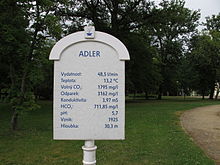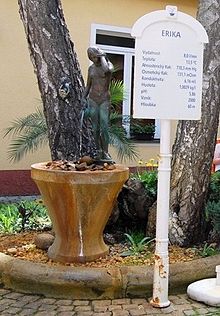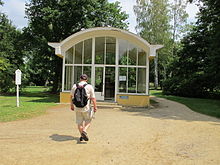Medicinal springs in Františkovy Lázně
In the Czech spa town of Františkovy Lázně ( Franzensbad ) a total of 24 springs are recognized as medicinal springs . They give sulphurous acidic water and are considered to be sour wells . The average temperature of the springs is 11 ° C. Not all sources are suitable for use in drinking cures; some are used for therapeutic baths.
Description of the individual sources
Adlerquelle (Pramen Adler)
The Adlerquelle was put into operation in 1925 and is used for spas. She is named after the doctor Dr. Bernhard Adler , the founder of the spa. There is a statue of an eagle near the spring that rises in front of the salt and meadow colonnade.
| Surname | CO 2 content | Mineralization | PH value | temperature | Bulk | depth |
|---|---|---|---|---|---|---|
| Adlerquelle | 1795 mg / l | 3162 mg / l | 5.7 | 13.2 ° C | 48.5 l / min | 30.3 m |
Cartellieri Spring (Pramen Cartellieri)
The Cartellieri spring rises behind the mud bath (Slatinné Lázne) and is used for mud baths. It was named after the spa doctor and honorary citizen of Franzensbad Paul Cartellieri .
| Surname | CO 2 content | Mineralization | PH value | temperature | Bulk | depth |
|---|---|---|---|---|---|---|
| Cartellieri source | 1255 mg / l | 2421 mg / l | 5.51 | 11.6 ° C | 80 l / min | 5.3 m |
Iron Spring (Železnatý Pramen)
The spring, named for its high iron content, was discovered and put into operation in 1863. Your water is recommended for tiredness and general exhaustion as part of a drinking cure and is described as tasty.
| Surname | CO 2 content | Mineralization | PH value | temperature | Bulk | depth |
|---|---|---|---|---|---|---|
| Iron source | 1998 mg / l | 2890 mg / l | 5.49 | 11.2 ° C | 2.9 l / min | 3.6 m |
Erikaquelle (Pramen Erika)
The Erikaquelle is prescribed for general weakness of the body, during convalescence and for mild digestive disorders. The spring is also used for spa baths. The medicinal water is used as a drinking cure for diseases of the kidneys and urinary bladder. Erika mineral water was taken in 1999.
| Surname | CO 2 content | Tightness | PH value | temperature | Bulk | depth |
|---|---|---|---|---|---|---|
| Erikasquelle | 1820 mg / l | 1002.9 mg / l | 5.86 | 13.5 ° C | 8 l / min | 60.0 m |
Franzensquelle (Františkuv pramen)
The Franzensquelle is probably the most famous spring in the city and has existed for the longest. There are reports about this spring from before 1400. It was taken in 1793. In the 15th century it was known under the name Egerbrunnen or Egerer Sauerwasser. It is said to be helpful for mild digestive disorders and to support general convalescence. It got its name from the Austrian Emperor Franz I.
| Surname | CO 2 content | Mineralization | PH value | temperature | Bulk | depth |
|---|---|---|---|---|---|---|
| Franzensquelle | 1000 mg / l | 1359 mg / l | 5.8 | 10.5 ° C | 6-8 l / min | 7.8 m |
Glauber I – IV
Several springs contain a high proportion of Glauber's salt and are called Glauber. They are numbered. All four are known for their effects on the gastrointestinal tract and were discovered around 1920. Glauber I and II arise away from the spa center near the Schwanensee. They are both framed with small pavilions. Glauber III and IV arise in the Glauber Hall ( Dvorana Glauberových Pramenù ) and are therefore one of the main attractions of the spa center. Glauber IV is the spring with the world's highest content of Glauber's salt.
| Surname | CO 2 content | Mineralization | PH value | temperature | Bulk | depth |
|---|---|---|---|---|---|---|
| Glauber I. | 24.17 mg / l | 8332 mg / l | 5.8 | 11.1 ° C | 2.2 l / min | 33.3 m |
| Glauber II | 14.41 mg / l | 5419 mg / l | 5.96 | 10 ° C | 1.3 l / min | 26.5 m |
| Glauber III | 16.24 mg / l | 7876 mg / l | 6.48 | 11.5 ° C | 62.2 l / min | 52.9 m |
| Glauber IV | 1534 mg / l | 20052 mg / l | 6.48 | 12.5 ° C | 0.9 l / min | 92.6 m |
Kaiserquelle (Císarský pramen)
The Kaiserquelle rises outside of Franzensbad in the nearby Soos nature reserve .
| Surname | CO 2 content | Mineralization | PH value | temperature | Bulk | depth |
|---|---|---|---|---|---|---|
| Kaiserquelle | 1810 mg / l | 7594 mg / l | 5.82 | 10.5 ° C | 8.7 l / min | 40 m |
Cold sparkling water (Studený Pramen)
The cold spring was discovered in 1817 and directed into the Luisenquelle pavilion. The water is mainly used for therapeutic baths.
| Surname | CO 2 content | Mineralization | PH value | temperature | Bulk | depth |
|---|---|---|---|---|---|---|
| Cold fizz | 1810 mg / l | k. A. | 6.13 | 11.5 ° C | 60 l / min | 60 m |
Luisenquelle (Luisin pramen)
The Luisenquelle is named after Marie-Louise of Austria . It has been in use since 1806 and is therefore the second oldest spring in Franzensbad. The source is built over with a pavilion named after the source.
| Surname | CO 2 content | Mineralization | PH value | temperature | Bulk | depth |
|---|---|---|---|---|---|---|
| Luisenquelle | 492 mg / l | 1596 mg / l | 5.92 | 10.4 ° C | 60 l / min | 22.4 m |
Natalie Source (Pramen Natálie)
The Natalie Spring was discovered in 1878 and built over with a colonnade of the same name in 1880. It is considered tasty and refreshing.
| Surname | CO 2 content | Mineralization | PH value | temperature | Bulk | depth |
|---|---|---|---|---|---|---|
| Natalie Source | 1917 mg / l | 1523 mg / l | 5.39 | 11.7 ° C | 4.0 l / min | 3.3 m |
New Church Spring (Nový Kostelní pramen)
Like Glauber III and IV, the Neue Kirchenquelle is built over with the Glauberhalle. It was only opened in 1999 and rises in great depth. It is considered tasty and is used for drinking cures.
| Surname | CO 2 content | PH value | temperature | Bulk | depth |
|---|---|---|---|---|---|
| New church source | 1591 mg / l | 5.96 | 14 ° C | 45 l / min | 63 m |
New source (Nový pramen)
The Neue Quelle is built over with a pavilion, which is located next to the Glauberhalle. It was opened in 1849 and is characterized by its particularly iron-rich water.
| Surname | CO 2 content | Mineralization | PH value | temperature | Bulk | depth |
|---|---|---|---|---|---|---|
| New source | 1671 mg / l | 1907 mg / l | 5.6 | 11.1 ° C | 23.0 l / min | 4 m |
Palliardi source
The spring discovered in 1870 is named after the doctor Dr. Palliardi, who was known for the healing treatment with mud baths. The water is considered to be particularly tasty and is considered helpful for digestive disorders and inflammation of the gastric mucosa. The spring is also called the fountain of youth of love. A corresponding effect is nowhere proven.
| Surname | CO 2 content | Mineralization | PH value | temperature | Bulk | depth |
|---|---|---|---|---|---|---|
| Palliardi source | 2063 mg / l | 2468 mg / l | 5.6 | 12.4 ° C | ? l / min | 3.4 m |
Source D14 (also Marian source or D XIV)
The D14 spring, mainly used for baths, has been in use since 1963.
| Surname | CO 2 content | Mineralization | PH value | temperature | Bulk | depth |
|---|---|---|---|---|---|---|
| Source D14 | 21.05 mg / l | 7473 mg / l | 5.81 | 10.5 ° C | 8.7 l / min | 40 m |
Salt Spring (Solný pramen)
The salt source is output as the above Wiesenquelle in built for both sources colonnade. It was developed in 1819 and is considered to be effective for diseases of the upper respiratory tract.
| Surname | CO 2 content | Mineralization | PH value | temperature | Bulk | depth |
|---|---|---|---|---|---|---|
| Salt spring | 2180 mg / l | 2956 mg / l | 6.01 | 11 ° C | 0.8 l / min | 2.8 m |
Sun spring (Slunecní pramen)
The source near the Schwanensee was only discovered in 1936. The water has a slightly laxative effect.
| Surname | CO 2 content | Mineralization | PH value | temperature | Bulk | depth |
|---|---|---|---|---|---|---|
| Sun source | 2105 mg / l | 7473 mg / l | 5.81 | 10.5 ° C | 8.7 l / min | 40 m |
Sophienquelle (Pramen Žofie)
The Sophienquelle rises behind the colonnade of the Natalie-Quelle. It was discovered in 1885 and its water is considered to be beneficial for diseases of the kidneys and the urinary bladder. It is used for drinking cures.
| Surname | CO 2 content | Mineralization | PH value | temperature | Bulk | depth |
|---|---|---|---|---|---|---|
| Sophienquelle | 1582 mg / l | 997.8 mg / l | 5.4 | 11.5 ° C | 12.0 l / min | 7.1 m |
Stanislav Spring (Pramen Stanislav)
The Stanislav well, which was only drilled in 1981, is very productive. It is located in the northern part of the city park. Your water has a digestive effect.
| Surname | CO 2 content | Mineralization | PH value | temperature | Bulk | depth |
|---|---|---|---|---|---|---|
| Stanislav source | 2174 mg / l | 4736 mg / l | 5.82 | 12 ° C | 120 l / min | 61 m |
Stefanie source
The water from the spring, which has been in use since 1878, is now bottled as mineral water.
| Surname | CO 2 content | Mineralization | PH value | temperature | Bulk | depth |
|---|---|---|---|---|---|---|
| Stefanie source | 1582 mg / l | 997.8 mg / l | 5.4 | 11.5 ° C | 12 l / min | 7.1 m |
Meadow spring (Lucní pramen)
The meadow spring is one of the springs after which the salt and meadow spring colonnade is named and can also be tapped there. It has been used since 1823 and is considered to be tasty.
| Surname | CO 2 content | Mineralization | PH value | temperature | Bulk | depth |
|---|---|---|---|---|---|---|
| Meadow spring | 2568 mg / l | 3443 mg / l | 5.97 | 10.4 ° C | 4.5 l / min | 3.6 m |
Web links
- Franzensbad (Františkovy Lázne). Quellenatlas.eu, accessed on August 16, 2014 .
- Jaroslav Dvorak and Jiri Krásny: Results from the healing water protection project in the Frantiskovy Lazne area, Czech Republic. October 5, 2005, accessed on August 18, 2014 (PDF, 266 kB).
- Franzensbader springs and other medicinal products. Františkovy Lázně Information Center, accessed on August 18, 2014 .








